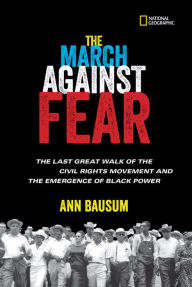Book Review: The March Against Fear: The Last Great Walk of the Civil Rights Movement and the Emergence of Black Power by Ann Bausum
Publisher’s description
 James Meredith’s 1966 march in Mississippi began as one man’s peaceful protest for voter registration and became one of the South’s most important demonstrations of the civil rights movement. It brought together leaders like Martin Luther King Jr. and Stokely Carmichael, who formed an unlikely alliance that resulted in the Black Power movement, which ushered in a new era in the fight for equality.
James Meredith’s 1966 march in Mississippi began as one man’s peaceful protest for voter registration and became one of the South’s most important demonstrations of the civil rights movement. It brought together leaders like Martin Luther King Jr. and Stokely Carmichael, who formed an unlikely alliance that resulted in the Black Power movement, which ushered in a new era in the fight for equality.
The retelling of Meredith’s story opens on the day of his assassination attempt and goes back in time to recount the moments leading up to that event and its aftermath. Readers learn about the powerful figures and emerging leaders who joined the over 200-mile walk that became known as the “March Against Fear.”
ADVERTISEMENT
ADVERTISEMENT
Thoughtfully presented by award-winning author Ann Bausum, this book helps readers understand the complex issues of fear, injustice, and the challenges of change. It is a history lesson that’s as important and relevant today as it was 50 years ago.
Amanda’s thoughts
This powerful book examines one of the greatest civil rights protests and the last great march of that era—a march that is often forgotten, was fraught with complexity, and led to divisions in the civil rights groups and leaders of the time.
Bausum begins with the shooting of James Meredith, who was the first African American to earn a degree at Ole Miss, among the first to integrate the Air Force, and felt he had a “divine responsibility” to be a leader for his race. Meredith’s walk across Mississippi was for a simple reason: he was tired of being afraid of white people and he wanted black people to stop being afraid. He felt that if he could walk through his state like this, he might inspire people to be less afraid and get them out to vote. His plan was cut short when he was shot. However, his walk was then taken up by Martin Luther King, Jr. and other civil rights activists and groups. Their focus was on voter registration and civil rights bills. They created a document calling on President Johnson to enforce legal rights of African Americans, provide increased economic opportunities, improve voting access, and have great representation by black people on juries and police forces. Meredith’s Walk Against Fear morphs into the March Against Fear, an undertaking that lasts most of June 1966 and eventually involves thousands of people bringing attention to segregation and the legacy of slavery. It is at this march that Willie Ricks and Stokely Carmichael first use and encourage the phrase “black power,” changing the call and response from “What do you want?” “Freedom!” to “What do you want?” “Black power!” for many in the march. Bausum’s book looks at the role of the news media and of the governments and police forces of the areas during the march as well as the unity and divisions of the civil rights groups during the march and effects after.
With plenty of source material, including many pictures from the march, this book is both well-written and well-researched. A large appendix details Bausum’s source material, including personal conversations with Meredith. Civil rights and social justice will always be relevant topics, and contemporary readers will be struck by just how little has been done to really move our country forward and how the topics important to the leaders during the march remain just as significant today. An important look at racism, protest, and the slow move toward progress.
Review copy courtesy of the publisher and Edelweiss
ISBN-13: 9781426326653
Publisher: National Geographic Society
Publication date: 01/03/2017
Filed under: #SJYALit, Book Reviews
About Amanda MacGregor
Amanda MacGregor works in an elementary library, loves dogs, and can be found on Twitter @CiteSomething.
ADVERTISEMENT
ADVERTISEMENT
SLJ Blog Network
The Moral Dilemma of THE MONSTER AT THE END OF THIS BOOK
Cover Reveal and Q&A: The One and Only Googoosh with Azadeh Westergaard
K is in Trouble | Review
Parsing Religion in Public Schools
ADVERTISEMENT







